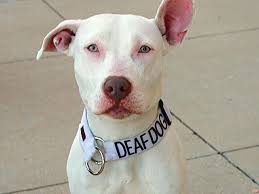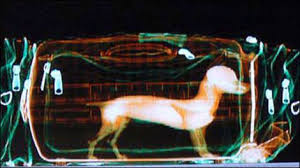How Tiny Creatures Manipulate Behavior and Shape Society
Kathleen McAuliffe, This Is Your Brain On Parasites
 Science author Kathleen McAuliffe explains the link between Toxoplasma, a parasite cats can transmit, and it's potentially profound effects on humans, including schizophrenia and even suicide. Even dogs can be responsible for transmitting fatal parasites. This is not fiction. Every pet owner should be aware.
Science author Kathleen McAuliffe explains the link between Toxoplasma, a parasite cats can transmit, and it's potentially profound effects on humans, including schizophrenia and even suicide. Even dogs can be responsible for transmitting fatal parasites. This is not fiction. Every pet owner should be aware.
One such parasite is Toxoplasma, which make rodents attracted to open spaces and the smell of cats, which, in turn, eat them and help the parasite complete its life cycle. Cats normally shed the parasites' eggs in their feces where rodents will pick them up from the ground.
Humans can be exposed to this when changing or cleaning a cat's litter box. That's not the only way a human can contract it, you an also get it from eating rare meat. This is because grazing cattle can pick the parasite up from the ground and it can be incorporated in their tissue, which is what humans eat.
French people, for example, eat a lot of rare meat and about 50-percent of French people have this parasite in their brains, while about 20-percent of Americans have the parasite.
Typically, when you are first exposed to the parasite, you might develop flu-like symptoms and then feel fine. At that point, what has happened is that the parasite has nestled down inside your neurons, as it is attracted to your brain. Normally it stays dormant within the brain. However, you can get acute symptoms like inflammation of the brain, which can actually kill you. But again, normally for most healthy people, it stays dormant.
But for reasons no one understands, for some people it can cause problems and is now being associated with some types of mental illnesses. It has also been associated with suicide and many studies over the years have also connected it with schizophrenia. People who have tested positive for the parasite are 2 to 3 times as likely to be diagnosed with schizophrenia.
Strangely enough, it has also been linked to car crashes. People who are infected with this parasite are more likely to be involved in car crashes where they are at fault, suggesting that the parasite may trigger impulsivity or recklessness.
Another parasite that is found in dogs is Toxocara, or roundworms. These are pale, wriggling threads that you sometimes see that your dog may cough up or you might see the thin strands in your pet's stool. Those worms lay microscopic eggs. When these eggs get inside our bodies, they can never grow into an adult worm. However, its development is arrested at the highly mobile larvae stage, when it is only a few millimeters long, and it can then leave your gut and travel to different tissues in the body, like your lung and liver and sometimes even your brain.
 There was a major study done of 4,000 children and they found that children who were infected with the Toxocara parasite did worse on all cognitive tests. They also had slightly lower IQ's on average. While this parasite is as common as the Toxoplasma, there haven't been a lot of studies done on it.
There was a major study done of 4,000 children and they found that children who were infected with the Toxocara parasite did worse on all cognitive tests. They also had slightly lower IQ's on average. While this parasite is as common as the Toxoplasma, there haven't been a lot of studies done on it.
There are many other types of parasites that are tiny organisms, which can only live inside another animal, and as Kathleen reveals, they have many evolutionary motives for manipulating their host's behavior. Far more often than appreciated, these puppeteers orchestrate the interplay between predator and prey. With astonishing precision, parasites can coax spiders to transform the patterns of their webs and fish to draw the attention of birds that then swoop down to feast on them.
Take crickets and their fraught relationship with water. Once infected by parasitic worms, they hurl themselves into water where they can easily drown. This apparent suicide bid enables the worms to reproduce. Or parasitic wasps that turn cockroaches into "Zombies" that they drive back to their burrows. The cockroaches act as both home and larder for the wasps' developing young, which devour them from within.
While all of this sounds horrific, please don't let that deter your from getting a cat or dog. There are a lot of great benefits from having a pet. You just need to be educated and sensible and practice good hygiene.
Visit Website
Sailing The World With a Chicken
Guirec Soudee & Monique
 Guirec Soudee was a 24-year-old Frenchman who sailed around the world with the perfect companion - a chicken!
Guirec Soudee was a 24-year-old Frenchman who sailed around the world with the perfect companion - a chicken!
Monique, the chicken, was only about four or five months old then when Guirec met her. She had never left the Canary Islands. Guirec didn't speak any Spanish and she didn't speak any French, but they got along. When Guirec first saw Monique - he knew she was the one! They are now best friends.
Guirec, who is from Brittany in France, began his trip around the world with Monique, the chicken, in May 2014. After starting from the Canary Islands, Spanish territory near Africa's west coast, the pair sailed to St. Bart's in the Caribbean before moving into the Arctic.
While he didn't know anything about hens, Guirec thought it would be nice to have company on his trip. He thought about bringing a cat, but decided it would be too much effort to look after. Plus, Monique can provide him with fresh eggs in the middle of nowhere! People told him she would be too stressed to lay eggs, but she started laying them right away. Over an average week, Monique lays six eggs, even in the cold climates of Greenland and even during three months there without sun. While Monique had her own special food, they also shared many meals together, including fly fish that jumped on deck.
 Monique adjusted very well to life on a boat and has took up swimming, surfing and also windsurfing. Guirec was worried about her on the deck, but she did very well and had free roam, except in bad weather when Guirec put her in her hutch.
Monique adjusted very well to life on a boat and has took up swimming, surfing and also windsurfing. Guirec was worried about her on the deck, but she did very well and had free roam, except in bad weather when Guirec put her in her hutch.
Guirec tells us that Monique is the first chicken to go to Greenland, as there are no chickens there because of the cold. They were stuck in Greenland for about a year because of the ice and then they headed to Alaska and the West Coast.
Together, Guirec and Monique sailed around the world. Guirec's friends and family thought he was crazy, but Guirec didn't agree. He felt it is good to do things like traveling the world when you are young, not married and have no children.
You can see the adventures of Guirec and Monique on Facebook.
It's Not Doggie Asthma - It's a Reverse Sneeze - Dr. Debbie
 What dog owner hasn't heard that frightening sound that dogs make - part cough, part sneeze and often described as a dog being unable to catch his breath. But it really isn't asthma, or some kind of bone stuck in your dog's throat - it's a reverse sneeze. So before you panic and run into the veterinary office on emergency, ensure you know what a reverse sneeze is.
What dog owner hasn't heard that frightening sound that dogs make - part cough, part sneeze and often described as a dog being unable to catch his breath. But it really isn't asthma, or some kind of bone stuck in your dog's throat - it's a reverse sneeze. So before you panic and run into the veterinary office on emergency, ensure you know what a reverse sneeze is.
Meet the Reverse Sneeze
A reverse sneeze is a respiratory sound in a category all its own. Also known as a pharyngeal gag reflex or backwards sneeze, the reverse sneeze is a commonly observed respiratory sound in dogs, and less commonly in cats. While a true sneeze occurs on the exhale, the reverse sneeze occurs as the dog inhales. The result is a reverberating snorting, wheezing, episodic sound that lasts for a few seconds to a minute or two. A reverse sneeze is a completely harmless sound and dogs do not suffer any immediate health threat from these episodes.
How can you tell it's a reverse sneeze?
There is no easy explanation of the sound - you just have to hear it and you'll recognize it. Click to see and hear an example of a dog's reverse sneeze episode.
Part of my enjoyment on the weekly national radio program, Animal Radio, is describing the peculiar smells, sounds and essences of veterinary medicine with our listeners. On many an occasion when speaking to callers, I have re-created the sounds of reverse sneezing. I'm no Rich Little, but I do take pride in my impersonation of a canine reverse sneeze, which is admittedly better in person with the visuals to complement the throaty sound.
Characteristics of a dog displaying a reverse sneeze include:
- Vibrational coughing/wheezing sound
- Stiff, extended neck
- Facial grimace
- No discharge from nose
- Not followed by coughing or vomiting up material
- Not involving collapse episodes
- Animal is completely normal after event
What causes a reverse sneeze?
Some reverse sneeze episodes occur when a dog gets very excited or pulls against a leash. Brachycephalic breeds (short faced breeds) like Pugs and Boston terriers commonly display reverse sneezing due to their upper airway conformation.
 Allergies, respiratory infections, nasal mites, inhaled foreign bodies and masses can also trigger reverse sneezing. Dogs with inflammatory conditions such as lymphoplasmacytic rhinitis can also display bouts of reverse sneezing. And sometimes reverse sneezing occurs in the wee hours of the night, while a dog is sleeping, for no apparent reason. In fact, many veterinarians receive panicked phone calls at 2am from pet owners, concerned of impending asthma attacks or respiratory arrest, only to have it turn out just to be a typical case of reverse sneezing.
Allergies, respiratory infections, nasal mites, inhaled foreign bodies and masses can also trigger reverse sneezing. Dogs with inflammatory conditions such as lymphoplasmacytic rhinitis can also display bouts of reverse sneezing. And sometimes reverse sneezing occurs in the wee hours of the night, while a dog is sleeping, for no apparent reason. In fact, many veterinarians receive panicked phone calls at 2am from pet owners, concerned of impending asthma attacks or respiratory arrest, only to have it turn out just to be a typical case of reverse sneezing.
What to Do?
There is no required treatment for a reverse sneeze episode. However, I recommend stroking a dog's throat while gently speaking to him in a calm manner until the episode subsides. Some advocate closing/pinching the nostrils off, which forces a dog to swallow and curtails the reverse sneeze episode. Whatever the approach, reverse sneezing episodes are over within minutes, so no emergency treatment is indicated. Antihistamines may be prescribed to minimize reverse sneezing episodes.
When to Worry?
If all of a sudden your dog is having repeated bouts of reverse sneezing, evaluation by your veterinarian is indicated. Consult with your veterinarian if your dog is reverse sneezing along with other symptoms such as facial rubbing, nasal bleeding, nasal discharge, coughing, or significant sneezing episodes.
Nasal mites are a common cause of reverse sneezing and may be noted after a recent boarding visit, especially if multiple dogs in a household are involved. Nasal mite treatment is easily pursued with anti-parasite injections of ivermectin (or in collie breeds - the alternative Milbemycin.) If reverse sneezing is excessive and prolonged, the nasal and pharyngeal areas should be evaluated by a veterinarian through rhinoscopy - a procedure performed under anesthesia in which the nasal passages and pharyngeal areas are visualized with an endoscope, a micro camera. This is how foreign objects and masses are typically identified. In other cases, further tests may be needed including a CT scan or with biopsy samples from sinus passages.
Final Thought
The good news is that most of reverse sneezing episodes are harmless, and do not indicate any serious illness. Arm yourself with information by learning what a reverse sneeze looks like and you may save yourself an unwanted emergency veterinary visit over this peculiar but non-life threatening occurrence.
Featured veterinarian known as "Dr. Debbie" on national pet radio program, Animal Radio. Ebook author of "Yorkshire Terriers: How to Be Your Dog's Best Friend"; "Pugs: How to Be Your Dog's Best Friend"; "Mini Schnauzers: How to Be Your Dog's Best Friend"; and "Shih Tzu: How to Be Your Dog's Best Friend." Dr. Debbie's books.
Visit Website
5 Reasons Deaf Dogs Rock
Robert Semrow, Animal Radio Listomania
 I often attend the annual conference called BlogPaws. This conference always reminds of how great the pet world is. It's no wonder people like myself find such great peace, comfort and inspiration from it.
I often attend the annual conference called BlogPaws. This conference always reminds of how great the pet world is. It's no wonder people like myself find such great peace, comfort and inspiration from it.
One of the wonderful people that I've seen each year and stayed in touch with is Christina Lee, the President and Founder of Deaf Dogs Rock. As some of you know, I thought Sugar was deaf when she first adopted us. Turned out she was just extremely scared. Still, I learned from groups like Deaf Dog Rocks on how to handle it. She and her group have been doing wonderful things for Deaf Dogs for many years. I've learned much from them and their efforts. I'm inspired by them and others who do for others who are unable to do for themselves. So, in that spirit, here are 5 reasons that Deaf Dogs Rock!
If you are looking to adopt another family member, remember that a deaf dog is a special dog with special abilities that are enhanced. So let's start by stating that if you are considering a deaf dog or have found out your dog is deaf, there are as wonderful groups out there as there are wonderful deaf dogs. These groups will support you, educate you and help you become the best pet guardian you can ever hope to be. So, you are not alone in what is sure to be a wonderfully rewarding journey.
Next up, know that Deaf Dogs have no fear of fireworks, thunderstorms or other loud noises. One advantage of hearing loss is that these dogs do not know the fear or become anxious because of loud noises. This may seem obvious, but if you are in a loud environment, this is something that may be a tremendous advantage for you and your pet.
 Additionally, Deaf Dogs Rock because they are very much in tune and focused on their owners. Your deaf dog will be very much "listening" and watching for your hand signals, movements and gestures to give them guidance, comfort and of course joy. They want to be attentive to your direction and therefore will give you their attention even when there are lots of other distracting activities going on around them. Their adherence to your hand signals and gestures is a point of connection and love with you.
Additionally, Deaf Dogs Rock because they are very much in tune and focused on their owners. Your deaf dog will be very much "listening" and watching for your hand signals, movements and gestures to give them guidance, comfort and of course joy. They want to be attentive to your direction and therefore will give you their attention even when there are lots of other distracting activities going on around them. Their adherence to your hand signals and gestures is a point of connection and love with you.
Next, even though they can't hear, their smelling ability is enhanced and their sense of vibration is very keen. They are able to use their enhanced senses to give their owners warnings and alert them to movement, danger and anything approaching. They learn the scents of those around them and use that enhanced sense to keep watch. Finally, and this is the one that Christina and her folks always stress, Deaf Dogs Hear with their Hearts. This is one of the most beautiful realities of a deaf dog. It is love in their hearts that guides them and powers them.
They stick close to you, listen with their other enhanced senses and are powered by a sense of love and appreciation that is unmatched. There are so many other reasons Deaf Dogs Rock. May you all be blessed to meet one and learn for yourselves.
Share your deaf dog stories on our Animal Radio Facebook Page.
http://petworldinsider.com
The Dogfather's Grooming Tip with Joey Villani
Current Doggy Hairstyles
 Most people don't realize that pets have different styles of haircuts just like we do. It's not just a "One Size Fits All." This means that you can see many different haircuts in the same breed.
Most people don't realize that pets have different styles of haircuts just like we do. It's not just a "One Size Fits All." This means that you can see many different haircuts in the same breed.
But if you want your pet to be posh and keep up with he latest trend of things, you need to know what the current doggy hairstyles are, or at least your groomer should know.
One style is Asian Fusion Grooming. This is a creative way to make your dog actually look like a stuffed toy. Another way to visualize it, is to think of a woman wearing bell-bottoms that fit perfectly and look great. Well, that is the new hairstyle for dogs. They have short muzzles and fuzzy round head, while their legs are shaped to make them look like they are wearing bell-bottoms.
But be aware that the styles can vary from region to region. In Japan, Malaysia, Thailand and Taiwan you will find many of the same styles, but with a few different takes.
If you want your dog to be at the top of its game and you want to walk around town and have your dog wearing the best haircut, tell your groomer that you're interested in Asian Style Grooming.
If they don't know how to do it, tell them it's easy and that they should look at some pictures of dogs with this new style.
Animal Radio News - Lori Brooks
 Not Only Service Dogs, But All Dogs Help Children With Autism >
Not Only Service Dogs, But All Dogs Help Children With Autism >
The Human Animal Bond Research Initiative Foundation did a long-term study to explore the effects of pet dogs - not only service dogs - on families with children that have autism spectrum disorder. The findings were also published in the Journal of Veterinary Behavior and showed significantly improved family functioning of families with a dog compared to those without. The study also found a reduction in parent-child dysfunctional interactions among families that had a dog. Yes, while there is growing evidence that animal-assisted therapy can aid in the treatment of children with autism spectrum disorders, this study was one of the first to show how having a dog as a pet can also improve the lives of family members.
Dogs and Cats Don't Make the Best Pets
I bet if I asked you what the best pet is, you would say a dog or a cat, right? That might be your opinion, but a team of animal welfare experts at a University in the Netherlands rated 90 species of animals for a pet suitability ranking. Their criterion was the animals' basic biology, needs, the danger they pose to humans and how well they actually do when kept in captivity. Are you ready for this - according to the research aimed at a growing trend in the Netherlands of owning exotic pets, dogs, cats and rabbits are nowhere to be seen in the top 25 and the absolute best pet is a sika deer - a sweet little type of deer native to Japan. The other four animals in the top five are Agile Wallaby, Tamar Wallaby, llama and Asian Palm Civet. Keep in mind these rankings are not about preference, but about which pets will actually be happiest in your home and are "suitable" for keeping by anyone without special knowledge or skills.
 Smuggling Dogs In Suitcases
Smuggling Dogs In Suitcases
After gold, drugs and money, officials at India's biggest airport have added pet dogs to their list of 'smuggled' goods for their security agents to watch out for. Not long ago, staff manning the X-ray machines in the arrivals terminal found an unconscious dog stuffed between clothes in the suitcase of a woman traveling from Eastern Europe. She confessed to having sedated the dog and putting it in her checked luggage. And it's not the only time it has happened. The owners all did it to avoid doing all the required paperwork.
The "Lick" of Death
You've heard it a thousand times that a dog's mouth is cleaner than a human's mouth, but a medical report may debunk that statement. The British Medical Journal reported on a case it called the "Lick of Death," which documented how an elderly woman nearly died because of a kiss from her dog. The woman began slurring her speech while speaking on the phone and later was unresponsive. Upon arriving at the woman's home, paramedics discovered her semi-unconscious and slumped over in a chair. They rushed her to the hospital where her condition started to improve, but then took a turn for the worse after four days. She had a headache, fever and her kidneys started to shut down. Blood tests revealed she had sepsis and further testing found the cause to be Capnocytophaga Canimorsus, a bacterium often found in the mouths of dogs and cats. However, she had no scratch marks or bites on her skin, but it turns out that she has a very affectionate Italian Greyhound that loved giving her kisses and gave her the lick of death. Experts say it usually happens in people who are immunocompromised and usually follows a dog bite. One infectious disease expert said he has probably seen two cases in 30 years. Fortunately, the woman was able to recover after spending a month in the hospital.
 Don't Buy Dory!
Don't Buy Dory!
The Ornamental Aquatic Trade Association that represents the ornamental aquatic industry doesn't want fish keepers to buy regal tangs on a whim. If you don't know what a regal tang is this will help - it is the bright blue salt water fish that looks like "Dory," star of the Disney movie Finding Dory. The group thinks that the film may have encouraged impulse online purchases without people doing the proper research for caring for such a pet. The organization also advised first-time fish keepers to avoid regal tangs like Dory and clownfish like Nemo saying, "Like any pet, they deserve respect and a lot of research before you take the plunge into ownership. Do it right and ... "Don't buy a Dory or Nemo fish on a whim and hope it will all work out. It won't." They stress regal tangs and clownfish are not the fish to start with for beginners.
When Google Street View Doesn't Work - There Are Always Sheep!
Where hasn't Google Street View been? Well, a lot of places and that has not gone over well with people in more remote parts of the world like Denmark's tiny Faroe Islands where residents finally decided to map the islands themselves using sheep. The project was called "Sheep View 360." The islands' tourism bureau director couldn't find images of the islands on Google Street View, so she got a 360-degree camera and put it on a few of the seventy thousand sheep who roam the 18 rocky islands. She then uploaded pictures to Google Street View herself.
 Not Your Typical Pit Bull
Not Your Typical Pit Bull
Scout, the charismatic "Viking Dog" behind the Facebook and Twitter pages "Stuff on Scout's Head," wasn't a typical Pit Bull; he had thousands of followers on social media. He was an icon, a visionary, a published author and a household name for bully advocates. He was a great ambassador for his breed. Through the power of humor, Scout and his mom took the Internet by storm with their social media accounts, showcasing the loyalty and patience pit bull type dogs possess. Their accounts featured photos of Scout patiently balancing objects of all shapes and sizes on his "very flat (and kissable) head."
 Listen to the entire Podcast of this show (#1134)
Listen to the entire Podcast of this show (#1134)





